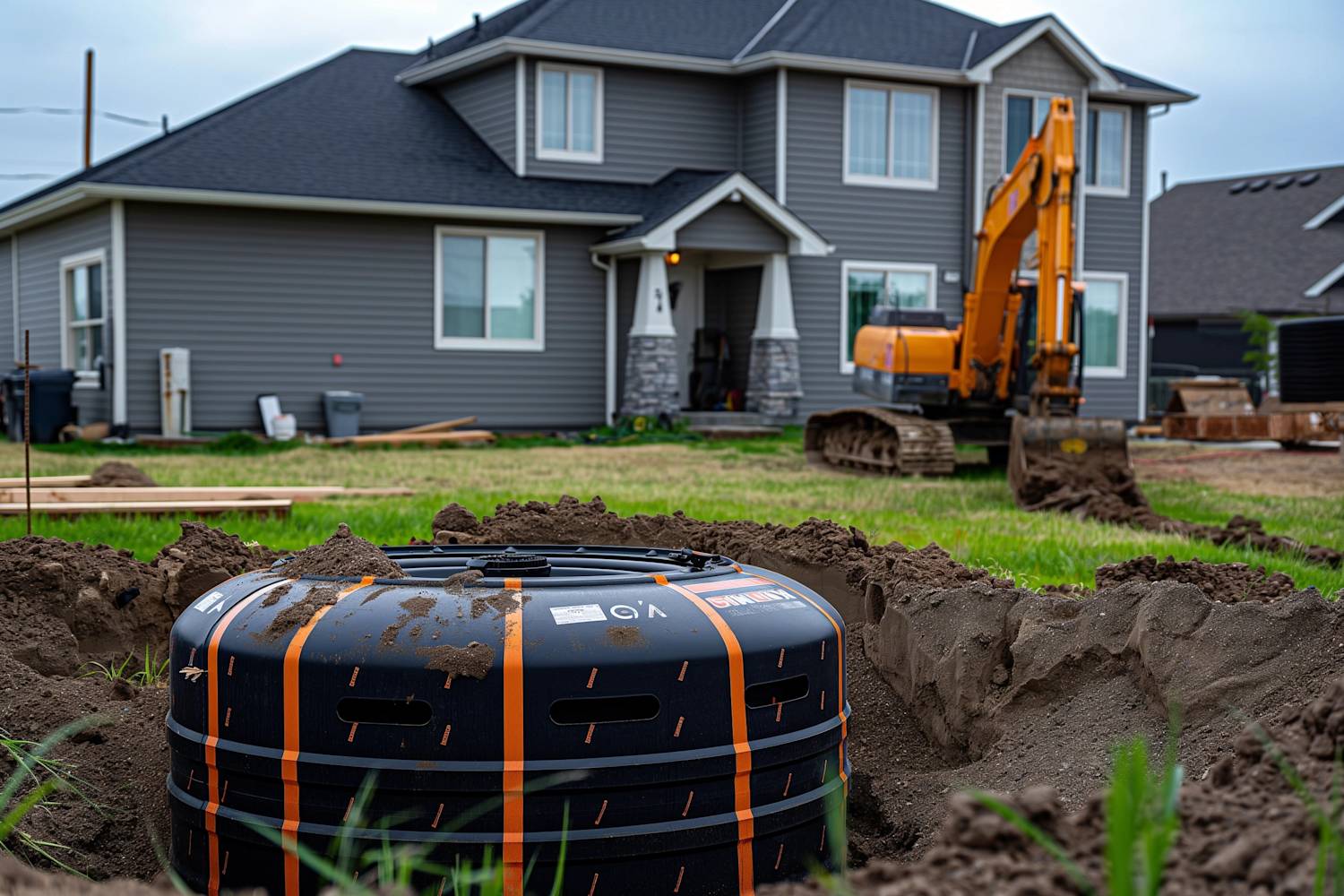Are you planning to install a septic system in your home or business property? That's a significant decision, and there's quite a bit to understand before you get started. "Septic system installation" isn't just about digging a hole in the ground and placing a tank; it involves an intricate process requiring expertise and precision. This process includes evaluating the location, considering the soil type, sizing the system correctly, understanding the different septic system types, along with their installation and maintenance requirements. This comprehensive guide serves to enlighten you regarding the technicalities involved in a septic system installation.
Understanding What a Septic System Is
Before we delve deeper into the intricacies of septic system installation, understanding what a septic system is and how it works is essential. A septic system is an independent sewage treatment system prevalent in areas not connected to the main sewage pipes provided by local authorities or private corporations. Essentially, these systems use a combination of nature and advanced technology to treat wastewater from household plumbing fixtures, including toilets, baths, kitchens, and laundry.
Septic System Basics
The standard septic system includes a septic tank (typically made of concrete, fiberglass, or plastic), and a drain field. The tank's work is to separate solid waste, allowing the remaining liquid wastewater to flow into the drain field for further treatment and disposal.
-
The septic tank is where the initial stage of wastewater treatment takes place. Here, solid waste materials are broken down and separated from the liquid.
-
The drain field is where the remaining wastewater gets naturally filtered and eventually seeps back into the surrounding soil. The soil neutralizes harmful bacteria and viruses before they reach the groundwater.
Choosing the Right Septic Tank Size
It's crucial to correctly size your septic tank to ensure efficient wastewater treatment and to prevent system failure. Tank size should mainly depend on the number of people in the house, factoring in the average amount of wastewater generated per person. Additionally, consider the potential of the house expanding in the future and base the tank size decision on those plans. Professional guidance can offer a more accurate determination.
Procedure for Septic System Installation
The installation process requires consideration of several factors and involves a sequence of steps that need to be followed accurately for the system to function correctly.
Site Assessment and Permits
Before the physical installation of the septic system, conduct a site inspection to gauge the property's characteristics. Site assessment involves determining the soil type (to evaluate its absorption properties), measuring the exact distance from the proposed septic tank to the house, nearby wells and water bodies, as well as from property boundaries. Any slope is also considered as it impacts the function of the drain field. It's essential to secure necessary permits from local authorities at this stage.
Excavating and Installing the Tank
Once site assessment and designing are complete, the next step is the excavation for the septic tank installation. This step requires detail and precision, since improper excavation can lead to tank instability or damage in the long run. After installing the tank, it’s filled with water to balance pressure and prevent it from moving when the first load of wastewater is introduced.
Installation of the Drain Field
The drain field installation follows the septic tank installment. It involves digging trenches in a previously identified area. Upon completion, a distribution box is placed to evenly spread wastewater across the entire drain field.
Septic System Installation Costs
Septic System installation costs may vary based on many factors such as the type of system, location, size of the system, the complexity of the install, permits needed, and more. On average, septic system installation ranges from $3,100 to $9,500, including the cost of the tank, labor, and additional materials. Do note that high-end installations can cost over $20,000.
Septic system installation is a complex task that requires a detailed understanding and expertise. It's necessary to hire experienced professionals to ensure a correct and efficient installation process. This guide has offered a detailed insight into the critical aspects involved in a septic system installation, aiding you in making informed decisions while undertaking this project.
Frequently Asked Questions About Septic System Installation
Why is a septic system necessary?
Septic systems serve as private wastewater treatment facilities especially designed for homes located in areas where municipal sewage lines are not accessible. They safely treat and dispose of wastes generated in these homes and hence, are an important part of a home’s infrastructure.
When should I think about septic system installation?
Septic system installation becomes necessary when you are constructing a new home that doesn't have access to a public sewer system. Additionally, if you are dealing with an old, failing, or inadequately sized septic system in an existing residence, you might need to consider a new septic system installation.
What are the key factors to consider during septic system installation?
Site selection is crucial during septic system installation. Other important factors to consider include characteristics of soil, size of the property, number of bedrooms in the home, and local regulations. You also need to consider the type of septic system that is best suited for your preferences and needs.
Can I handle septic system installation on my own?
While it might be tempting to try and install your septic system on your own, it's important to note that incorrect installation can lead to serious issues such as groundwater contamination and system failure. It is generally recommended to hire a professional for septic system installation to ensure that the job is done correctly and safely.
How long does septic system installation take?
The duration of the septic system installation process can vary based on factors like the complexity of the septic system, the condition of the soil, and weather conditions. On average though, you can expect that it might take anywhere from one to three days.
How costly is septic system installation?
The cost of septic system installation depends upon the size of the system, the type of installation, your geographical location, and the specific requirements of your property. It is always best to get estimates from experienced professionals to understand the potential costs properly.
What are the different types of septic systems I can consider during installation?
There are several types of septic systems available for installation, including conventional systems, chamber systems, mound septic systems, and aerobic treatment units. Each of these has its own advantages, disadvantages, and suitability depending on various factors.
What kind of maintenance is involved after septic system installation?
Regular maintenance is key for the longevity of your septic system. This involves regular pumping of the septic tank – typically every three to five years – and inspecting the tank annually for potential issues. Proper care and regular maintenance can significantly extend your septic system’s lifespan.
What signs may indicate potential issues with my installed septic system?
Signs that might indicate an issue with your installed septic system include slow drains, gurgling sounds, unpleasant odors, water pooling in your yard, or overly lush green grass around the septic tank area. If you notice any of these signs, it is recommended to seek professional help immediately.
Can a septic system installation affect the value of my property?
An efficient and well-maintained septic system can indeed increase the potential value of your property. On the other hand, a poorly maintained system can negatively impact your property's value and might even lead to costly repairs or replacements.
Pros of Installing a Septic System
Cost-Efficiency Over Time
-
Long-term savings: Once installed, septic systems can operate for years with minimal maintenance costs. Compared to the regular monthly fees associated with public sewer systems, a septic system can eventually recoup its installation costs.
-
No unexpected increase in costs: Unlike sewer bills that can fluctuate based on utility company rates and usage, costs associated with a septic system remain consistent after the initial installation.
Environmental Sustainability
-
Lower environmental impact: Septic systems utilize natural filtration processes, minimizing the amount of pollution that can seep into local water systems. This can contribute to a healthier local ecosystem.
-
Water conservation: Septic systems encourage mindful water usage, as excessive water can overwhelm the system. This consciousness for conservation ultimately helps the environment.
Independence from Municipal Sewer Systems
-
No reliance on local infrastructure: With a septic system installation, homeowners gain independence from city or municipal sewer systems, thus avoiding sewer line problems and municipal utility outages.
Cons of Installing a Septic System
High Upfront Costs
-
Initial investment: Septic system installation can be pricey. Costs can greatly vary depending on the size of the system, type of soil, and local regulations.
-
Unpredictable costs: Unforeseen difficulties during installation like rocky soil or a high water table can increase the upfront cost of installing a septic system.
Regular Maintenance and Possible Repairs
-
Regular maintenance requirement: Septic systems need regular inspections and pumping to prevent backup and failure, adding to the overall costs.
-
Potential for expensive repairs: Septic system damage can be costly to repair. Whether it’s due to system age, poor maintenance, or environmental factors, repair costs could be significant.
Potential for Lower Resale Value
-
Perceived disadvantage: Some potential buyers might view a property with a septic system as a detriment. They may fear potential maintenance issues or unfamiliarity with the system, potentially lowering the property’s resale value.
Limited Installation Locations
-
Site-specific needs: A septic system installation can be limited by the property's soil type, size, slope, and proximity to water sources. This requires a thorough site evaluation before installation.
-
Restricted land use: Once installed, the use of the land above and around the septic system may be limited. Restrictions can include building extensions, parking, or deep-rooted plantings.
Summary
That's the scoop on septic system installation. This process is critical for any home or business not connected to a public waste system. It's essential to get the right people on the job who can guide you through all the necessary steps and ensure a professional, secure install. The setups can be simple or complex, depending on local codes and landscape, but bear in mind it's not a do-it-yourself project.
The septic system installation process is wrapped in multiple stages, along with compliance to local regulations. Also, it involves careful selection of the area and planning. Still, once done right, it can last for more than 25 years, serving your property effectively and efficiently. Always hire professionals who have loads of experience, given the critical nature of this work.
All in all, septic system installation isn't something you can put off or fix with a half-hearted solution. It's a necessary service that, when done right, provides nothing but benefits. You won't have to worry about poor sanitation or damaging the environment. A well-installed septic system will take care of all waste disposal needs, making your life easier and cleaner.
About KYPD Plumbing
Welcome to KYPD Plumbing! We are your trusted professionals based in Nicholasville, KY, specialized in handling all your plumbing needs. With years of experience under our belt, we are dedicated to providing top-notch services with exceptional customer care. Our team is highly trained and well-equipped to tackle everything from minor repairs to major installations. If you're seeking reliable, efficient, and effective solutions for your plumbing worries, remember - your peace of mind is just a call away with KYPD Plumbing!
Tags: Septic System Installation, Septic Tanks, Drainfield Installation,















